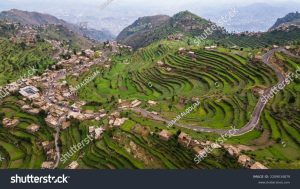YEMEN
Exploring Yemen’s Enchanting Geography :

YEMEN
Yemen, a captivating country situated at the southwestern edge of the Arabian Peninsula, boasts a landscape that is both dramatic and diverse. While the majority of its terrain is characterized by rugged mountains and arid expanses, there are regions graced with sufficient rainfall to nurture successful agricultural endeavors. This stark natural beauty is further enhanced by the rich tapestry of cultures and languages that thrive within its borders, with Arabic dialects and Islam predominating as unifying elements among its people.
The history of Yemen is a captivating narrative woven with the threads of its strategic location, serving as the gateway to the Red Sea. This has earned Yemen a pivotal role as the crossroads of both ancient and modern trade and communication routes. Millennia ago, the kingdoms that reigned over this land controlled the trade of precious commodities like frankincense, myrrh, spices, and aromatics from Asia. The region was not just fortunate but indeed blessed, and the ancient Romans aptly named it “Arabia Felix” in Latin, signifying its fertility and commercial prosperity amidst the forbidding expanse of “Arabia Deserta.”
Yemen’s historical significance transcends trade; it is also the birthplace of a globally cherished beverage – coffee. The cultivation of coffee, known as “kahwa” in Arabic, began right here. For an extended period, Yemen was the exclusive source of this valuable bean, long before it spread to other corners of the world.
The culture, economy, and vibrant population of Yemen have all been profoundly influenced by its storied past. This captivating land, with its rugged landscapes and thriving cultures, continues to be a captivating blend of old-world charm and contemporary relevance, encapsulating a unique allure that extends far beyond its borders.
give me some important question and answers for this topic”YEMEN”.
- Q: Where is Yemen located geographically?
A: Yemen is located on the southern tip of the Arabian Peninsula in the Middle East, bordered by Saudi Arabia to the north and Oman to the northeast.
- Q: What is the capital city of Yemen?
A: The capital city of Yemen is Sana’a.
- Q: How is Yemen’s geography characterized, and what are its major geographical features?
A: Yemen’s geography is diverse, featuring mountains, plateaus, and coastal plains. The country is known for its rugged terrain, including the Haraz Mountains and the Empty Quarter desert.
- Q: What is the official language of Yemen?
A: Arabic is the official language of Yemen.
- Q: What is the population of Yemen, and what are the major ethnic groups?
A: As of my last knowledge update in January 2022, Yemen’s population is estimated to be around 30 million. The major ethnic groups include Arabs and Afro-Arabs.
- Q: What is the predominant religion in Yemen?
A: The predominant religion in Yemen is Islam, with the majority of the population adhering to Sunni Islam, while a minority follows Zaidi Shia Islam.
- Q: What historical significance does Yemen hold, and what ancient civilizations were present in the region?
A: Yemen has a rich history and was home to ancient civilizations such as the Sabaeans and Himyarites. The city of Sana’a is one of the oldest continuously inhabited cities in the world.
- Q: How has Yemen been affected by political instability and conflicts in recent years?
A: Yemen has faced significant political instability and conflicts, including the ongoing civil war that began in 2014. The conflict has led to a humanitarian crisis, including food shortages and displacement of the population.
- Q: What is the significance of the Socotra Archipelago, and why is it considered unique?
A: The Socotra Archipelago, part of Yemen, is known for its unique and diverse ecosystems, including plant and animal species found nowhere else on Earth. It has been designated a UNESCO World Heritage Site.
- Q: How has Yemen been affected by the humanitarian crisis, and what are the key challenges the country faces?
A: Yemen faces a severe humanitarian crisis due to the ongoing conflict, with challenges such as food insecurity, malnutrition, and lack of access to healthcare and basic services.
- Q: What role does Yemen play in the geopolitics of the Arabian Peninsula and the Middle East?
A: Yemen’s geopolitical importance is influenced by its location at the southern tip of the Arabian Peninsula. The country’s stability and strategic location have implications for regional dynamics.
- Q: How is Yemen’s economy structured, and what are its main economic activities?
A: Yemen’s economy relies on agriculture, fisheries, and services. The ongoing conflict has severely impacted economic activities, leading to economic challenges and disruptions.
- Q: What is the status of Yemen’s cultural heritage, and are there notable cultural landmarks?
A: Yemen has a rich cultural heritage with historic cities like Sana’a, known for its unique architecture with traditional tower houses. However, the conflict has posed threats to the preservation of cultural landmarks.
- Q: How has Yemen been affected by environmental challenges, such as water scarcity and desertification?
A: Yemen faces environmental challenges, including water scarcity and desertification. The depletion of water resources has contributed to a critical water crisis in the country.
- Q: What international efforts are being made to address the crisis in Yemen, and what organizations are involved in providing humanitarian aid?
A: Various international organizations, including the United Nations and humanitarian NGOs, are involved in providing aid and addressing the humanitarian crisis in Yemen. Efforts include providing food assistance, healthcare, and support for displaced populations.

